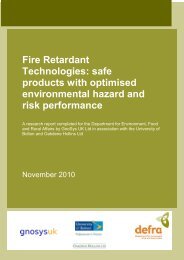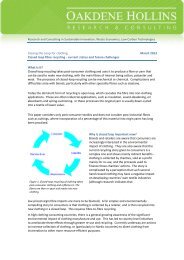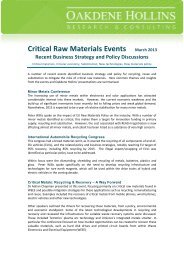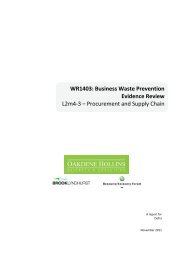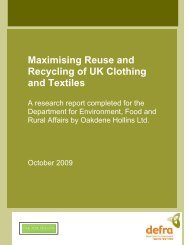Recycling of Low Grade Clothing Waste - Oakdene Hollins
Recycling of Low Grade Clothing Waste - Oakdene Hollins
Recycling of Low Grade Clothing Waste - Oakdene Hollins
Create successful ePaper yourself
Turn your PDF publications into a flip-book with our unique Google optimized e-Paper software.
© <strong>Oakdene</strong> <strong>Hollins</strong> Ltd, Salvation Army Trading Company Ltd<br />
Nonwovens Innovation & Research Institute Ltd September 2006<br />
Each volume includes a conclusions section, references and appendices,<br />
where appropriate, for each element <strong>of</strong> the project. Overall project findings<br />
and proposals are set out below, with key messages and data gaps that<br />
need to be filled, shown in bold type.<br />
1.3 Findings<br />
1.3.1 Economic and Market Analysis<br />
General<br />
The findings <strong>of</strong> this market study independently confirm that a<br />
combination <strong>of</strong> increasing affluence and lower prices <strong>of</strong> clothing and<br />
other textiles is causing a significant increase in the volume <strong>of</strong> textile<br />
products consumed in the UK. Specifically, new clothing sales volumes<br />
in the UK have increased by 60% in ten years. This has the potential to<br />
greatly increase the volume <strong>of</strong> textiles in the waste stream if all the new<br />
textiles consumed were discarded to waste. The secondary textile<br />
industry, which operates in a free market, collects just 17% <strong>of</strong> all textiles<br />
consumed domestically, with the balance being either stockpiled or<br />
discarded to the household waste stream.<br />
The study also confirms adverse perceptions within the secondary textiles<br />
industry <strong>of</strong> the economic and market situation and the impact <strong>of</strong> the ending<br />
<strong>of</strong> the Multi‐Fibre Arrangement. Although the industry is currently<br />
enjoying firm prices for used clothing, particularly in Eastern European<br />
markets, arising from the shortage <strong>of</strong> suitable quality material, these are<br />
seen as being short‐lived. In the longer term there is likely to be a decline<br />
due to falling prices in new clothing coupled with reducing product<br />
quality <strong>of</strong> used clothing being collected, and rising costs at all levels.<br />
Indeed, prices <strong>of</strong> new clothing are likely to continue to fall over the next<br />
five years. This has a double effect <strong>of</strong> placing higher volumes and lower<br />
qualities <strong>of</strong> used clothing on the markets which in turn is driving used<br />
clothing prices down thus affecting the long term viability <strong>of</strong> the textile<br />
recycling industry.<br />
Charity shops are responding by moving into the sale <strong>of</strong> alternative used<br />
products, such as books, toys and electronic media and into new products<br />
such as greeting cards and fair trade commodities. As a result, they are<br />
reducing the percentage <strong>of</strong> sales from used clothing. Some textile<br />
merchants are responding by closing down sorting activities and by<br />
shipping unsorted material directly to overseas traders or to sorting<br />
operations in low labour cost countries.<br />
For Defra Page 7



